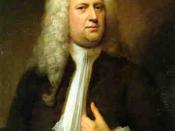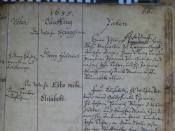Florentine Beginnings
Although musical drama, such as The Play of Daniel (12th cent.), had previously existed, it was in the year 1600 that opera came into being. It began in Florence, Italy, fostered by the camerata [society], a group of scholars, philosophers, and amateur musicians that included the librettist Ottavio Rinuccini (1562-1621) and the composers Vincenzo Galilei , Emilio del Cavaliere (c.1550-1602), Jacopo Peri , and Giulio Caccini . It was their aim to promote the principle of monodic musical declamation, i.e., a single melodic line with modest accompaniment inspired by the example of ancient Greek drama; accordingly, the earliest operas took their plots from mythology, the legend of Orpheus and Eurydice being one of the most popular.
Because the story hinges on the expressive power of music and solo song, the early composers referred to their work as dramma per musica [drama through music], and operas of the 17th and 18th cent.
used myth at first and plots about historical figures later. It had both lofty and comic strains, which were in time separated into distinct genres, the opera seria (serious opera) and the opera buffa (comic opera). Although fragments of Jacopo Peri's Dafne (c.1597) exist, the same composer's Euridice (1600), set to verse by Ottavio Rinuccini, is generally considered the first opera.
The Baroque in Rome and Venice
Development of earlier baroque opera occurred at Rome and Venice. The work that established Roman opera, Sant' Alessio, by Stefano Landi (c.1590-c.1639), appeared in 1632; it had a libretto by Giulio Rospigliosi (later Pope Clement IX). Landi modified the strict declamatory style of the Florentines with formal devices: the recitative and aria became clearly differentiated, and more prominent use was made of choruses and instrumental form. Also, the libretto included comic scenes, which had no part in earlier operas.
However, it was not until the appearance of Claudio Monteverdi in Venice that baroque opera reached its peak, and the art form that began as entertainment for the aristocracy became available to popular audiences. In 1637 the first public opera house in the world opened in Venice, and by 1700 at least 16 more theaters were built and hundreds of operas produced. In Venice, two of Monteverdi's best-known works, the early La Favola d'Orfeo ( The Tale of Orpheus, 1607) and L'Incoronazione di Poppea ( The Coronation of Poppea, 1642), were performed. Monteverdi's influence was considerable, for he may be said to be responsible for the introduction of bel canto and buffo styles. He also reflected the moods and dramatic vividness of the libretto in his music, and his work became a model for the operatic composers who followed.
With the next generation of Venetian composers, headed by Marcantonio Cesti (1623-69) and Pietro Francesco Cavalli , an international style developed, and local schools disappeared. The recitative diminished in musical interest in favor of the aria, the chorus gave way to the virtuoso soloist, and the Renaissance interest in antiquities was superseded by a trend toward lofty scenes punctuated by comedy and parody. Alessandro Stradella , a forerunner of the 18th-century Neapolitan school, wrote operas in this style.
Early French Opera
Officially, French opera began in 1669 with the establishment of the Académie royale de Musique, which was taken over by Jean Baptiste Lully in 1672 after the bankruptcy of its founders. Italian opera, the pastoral, French classical tragedy, and the ballet de cour (see ballet ) were the antecedents of French opera. Lully introduced his audience to grand-scale entertainment: lavish stage settings and scenery in addition to ballets, choruses, and long disquisitions on love and glory. His operas were divided into five acts and a prologue. The operas of Jean Philippe Rameau followed the tradition established by Lully, but were not as well received. Two of his works, however, Les Indes galantes ( The Gallant Indies, 1735) and Castor et Pollux (1737), have music surpassing their librettos.
Italian Opera of the Seventeenth and Eighteenth Centuries
Italian opera seria continued to dominate the musical scene throughout the 17th and 18th cent. The Neapolitans cultivated opera seria, notably in the works of Alessandro Scarlatti . Musical and dramatic interest became focused on the grandiose, so-called da capo arias, which make up the bulk of these operas. In the typical da capo aria, the principal emotion is symbolized by a large opening main section, which is repeated, often in a heavily ornamented fashion, after a contrasting "B" section. One of the most influential librettists of this period was Pietro Metastasio , in whose works the separation of serious and comic opera is complete.
Neapolitan opera became known as well for the importance it gave to comic opera as a separate genre. Comedy had maintained its place in the opera house mainly in the form of brief interludes, or intermezzi (see intermezzo ), that were played between the acts of opera seria. Now it came into its own, with such works as Giovanni Battista Pergolesi 's La serva padrona ( The Servant as Mistress, 1733), Giovanni Paisiello's (1740-1816) Il Barbiere di Siviglia ( The Barber of Seville, 1782), and Domenico Cimarosa 's Il matrimonio segreto ( The Secret Marriage, 1792). The characters were from commedia dell'arte , the subject matter satirical and earthy, replacing the staid classical heroism of earlier operas. There was no spoken dialogue.
The Development of English Opera
The first English opera was The Siege of Rhodes, with a text by poet laureate Sir William D'Avenant , in 1656. The masque was the true antecedent of English opera, and John Blow 's Venus and Adonis (c.1685) was actually an opera. The one great English opera of the 17th cent. was Dido and Aeneas (1689) by Henry Purcell , after whose death England succumbed completely to Italian opera.
The reigning "English" composer was a German who had completely absorbed the Neapolitan Italian style, George Frideric Handel . Although best known as the composer of the oratorio Messiah, Handel spent most of his musical energy between 1705 and 1738 in composing operas. His first opera in England was Rinaldo (1711), an instant success, and among the many other operas he composed are Giulio Cesare (1724), Rodelinda (1725), and Alcina (1735). Handel's operas featured castrati (see castrato ), who had great popularity, and who dominated this period and type of opera, sometimes forcing composers to write around them, adding music that had little or nothing to do with the plot.
Coincident with Handel's efforts at establishing Italian opera in England were the attempts of native talent to produce an English musical theatrical form. The result was The Beggar's Opera (1728), with a libretto by the poet John Gay and music composed partly by John Christopher Pepusch . The Beggar's Opera inaugurated the form of ballad opera that satirized Italian opera and contemporary politics.
German and Austrian Opera in the Eighteenth Century
The ballad opera eventually led to the singspiel, the German comic opera with spoken dialogue, which was to reach its highest development in the works of Wolfgang Amadeus Mozart . Although the early court opera of Germany showed preference for the Italian schoolFrederick the Great is said to have compared German singing to the neighing of horsesin the 18th cent. German composers began to turn their attention to singspiel.
Georg Philipp Telemann had anticipated the technique of Pergolesi's La serva padrona in his Pimpione (1725), a comic opera with only two characters. In the same vein is Johann Christian Standfuss's (?-1756) Der Teufel ist Los ( The Devil to Pay, 1752), an unpretentious composition written in the simple style of folk melody. However, it was Mozart's Die Entführung aus dem Serail ( The Abduction from the Seraglio, 1782) that fully established singspiel in Vienna, the international music capital. Singspiel had now become fused with Italian aria-oriented opera.
The increasing taste of the 18th-century public for musical portrayal of emotion in a more earnest manner and on a more human scale had its most significant impact on opera seria in the works of Christoph Willibald von Gluck . In a letter to the Grand Duke Leopold of Tuscany, Gluck stated his principal aim: "I sought to restrict music to its true function, namely to serve poetry by means of expressionand the situations which make up the plotwithout interrupting the action." He accomplished that aim with Orfeo ed Euridice (1762) and Alceste (1767).
The unity of drama and music was continued by Mozart, through his explorations of and expansions on the comic styles. His music manages to present characters familiar to every age, with all the virtues and foibles of the human race. Goethe compared him with Shakespeare. His major librettist was Lorenzo da Ponte (1749-1838), who produced texts for three of Mozart's greatest works: Le Nozze di Figaro ( The Marriage of Figaro, 1786), Don Giovanni (1787), and Così fan tutte ( Women Are Like That, 1790). In La clemenza di Tito (1791) Mozart used the work of Pietro Metastasio for his libretto. The libretto for Mozart's last great opera, Die Zauberflöte ( The Magic Flute, 1791) was written by Emmanuel Schickaneder (1751-1812).
![[Opera House staircase, Paris, France] (LOC)](https://s.writework.com/uploads/17/171573/opera-house-staircase-paris-france-loc-thumb.jpg)


Plegerise often?
http://www.infoplease.com/ce6/ent/A0860140.html
0 out of 0 people found this comment useful.